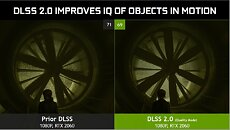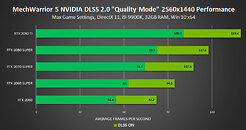Monday, March 23rd 2020

NVIDIA Announces DLSS 2.0 and New GeForce 445.75 Game Ready Drivers
NVIDIA today announced its new Deep Learning Supersampling 2.0 (DLSS 2.0) performance enhancement feature, being distributed through the new GeForce 445.75 Game Ready drivers. DLSS 2.0 is NVIDIA's second attempt at a holy grail of performance boost at acceptable levels of quality loss (think what MP3 did to WAV). It works by rendering the 3D scene at a lower resolution than what your display is capable of, and upscaling it with deep-learning reconstructing details using a pre-trained neural network. Perhaps the two biggest differences between DLSS 2.0 and the original DLSS that made its debut with GeForce RTX 20-series in 2018, is the lack of a need for game-specific content for training the DLSS neural net; and implementation of a rendering technique called temporal feedback.
As mentioned earlier, DLSS 2.0 offers image quality comparable to original resolution while only rendering 1/4 or1/2 the pixels. It then uses new temporal feedback techniques to reconstruct details in the image. DLSS 2.0 is also able to use tensor cores on GeForce RTX GPUs "more efficiently," to execute "2x faster" than the original DLSS. Lastly, DLSS 2.0 gives users greater control over the image quality, which affects the rendering resolution of your game: quality, balanced (1:2), and performance (1:4), where the ratio denotes rendering-resolution to display resolution. Resolution scaling is a sure-shot way to gain performance, but at noticeable quality loss. DLSS uses AI to restore some of the details. The difference between performance gained from resolution scaling and AI-based image quality enhancement is the net DLSS performance uplift. In addition to DLSS 2.0, GeForce 445.75 drivers come game-ready for "Half Life: Alyx."
DOWNLOAD: NVIDIA GeForce 445.75 Game Ready Drivers with DLSS 2.0When DLSS 2.0 is enabled in a supported game, its game engine generates two inputs to the AI network. One is a sequence of aliased lower-resolution frames, and the other is a synchronous sequence of motion vectors (data that tells DLSS 2.0 in which direction objects in a 3D scene are moving from frame to frame). The two are fed into an AI network called convolutional autoencoder. This takes in a lower-resolution 'current' frame, a higher resolution previous frame, and determines on a pixel-by-pixel basis how to generate a higher quality current frame. Currently, DLSS 2.0 is implemented in four fairly recent games: "Control," "Wolfenstein: Youngblood," "MechWarrior 5: Mercenaries," and "Deliver Us The Moon."NVIDIA posted some impressive performance improvement figures for DLSS 2.0 from its own testing.The driver change-log follows.
Game Ready
As mentioned earlier, DLSS 2.0 offers image quality comparable to original resolution while only rendering 1/4 or1/2 the pixels. It then uses new temporal feedback techniques to reconstruct details in the image. DLSS 2.0 is also able to use tensor cores on GeForce RTX GPUs "more efficiently," to execute "2x faster" than the original DLSS. Lastly, DLSS 2.0 gives users greater control over the image quality, which affects the rendering resolution of your game: quality, balanced (1:2), and performance (1:4), where the ratio denotes rendering-resolution to display resolution. Resolution scaling is a sure-shot way to gain performance, but at noticeable quality loss. DLSS uses AI to restore some of the details. The difference between performance gained from resolution scaling and AI-based image quality enhancement is the net DLSS performance uplift. In addition to DLSS 2.0, GeForce 445.75 drivers come game-ready for "Half Life: Alyx."
DOWNLOAD: NVIDIA GeForce 445.75 Game Ready Drivers with DLSS 2.0When DLSS 2.0 is enabled in a supported game, its game engine generates two inputs to the AI network. One is a sequence of aliased lower-resolution frames, and the other is a synchronous sequence of motion vectors (data that tells DLSS 2.0 in which direction objects in a 3D scene are moving from frame to frame). The two are fed into an AI network called convolutional autoencoder. This takes in a lower-resolution 'current' frame, a higher resolution previous frame, and determines on a pixel-by-pixel basis how to generate a higher quality current frame. Currently, DLSS 2.0 is implemented in four fairly recent games: "Control," "Wolfenstein: Youngblood," "MechWarrior 5: Mercenaries," and "Deliver Us The Moon."NVIDIA posted some impressive performance improvement figures for DLSS 2.0 from its own testing.The driver change-log follows.
Game Ready
- Half-Life: Alyx
- Resident Evil 3
- Ghost Recon Breakpoint's Ghost Experience update
- Addition of NVIDIA DLSS 2.0 to Control and MechWarrior 5: Mercenaries.
- ACE COMBAT 7: SKIES UNKNOWN
- Blacksad: Under the Skin
- Blair Witch
- Close to the Sun
- Hell Let Loose
- Journey To The Savage Planet
- Monster Energy Supercross 3
- MotoGP 19
- MXGP 2019 - The Official Motocross Videogame
- eFootball PES 2020
- World War 3
- Druidstone: The Secret of the Menhir Forest
- Phoenix Point
- Tamarin
- Will To Live Online
- Yakuza Kiwami 2
- [Notebook][H-Clone]: With the integrated graphics processor as the clone source, display settings cannot be changed from the NVIDIA Control Panel. [200594188]
- [Doom Eternal]: Flickering occurs in the ShadowPlay on-screen settings when in-game VSync is OFF. [200593899]
- [Call of Duty - Warzone]: ShadowPlay and Screenshot capture does not work with Windows 7 (200593494)
- [World of Warcraft: Battle for Azeroth][DirectX 12]: The game crashes when switched from DirectX 11 to DirectX 12 mode. [200574934]
- [Notebook][H-Clone]: With the integrated graphics processor as the clone source, display settings cannot be changed from the NVIDIA Control Panel. [200594188]
- [SLI][Red Dead Redemption 2]: With SLI, G-SYNC, and V-Sync enabled, increased flickering occurs in the game. [2858046]
- To work around, disable V-Sync.
- [Strange Brigade (DirectX 12)]: Green color corruption appears in the game when the output color format is set to YCbCr 420 or 12bpc. [200588227]
- To work around, use a different color space such as 422 or 444.
- [Resident Evil 3 Remake]: The bundled GeForce Experience doesn't support freestyle for the game. [2897138]
- [SLI][Doom Eternal]: Corruption occurs in the game upon opening the Steam overlay.[200593967]
- [DOOM Eternal]: Error occurs in the game while capturing Super Resolution (AI Upres) Image with Ansel.[200597765]
- [Doom Eternal]: The game frame rate drops when using the Steam in-game FPS counter. [200593988]
- This issue also occurs with non-NVIDIA graphics hardware.
- [DOOM Eternal][HDR]: The game flickers when OS HDR is set to OFF and in-game HDR is set to ON.[2874172]
- To work around, enable "Play HDR games and apps" from the Windows HD Color Settings menu.
- [Call of Duty: Modern Warfare]: Game may display white flashes when player approaches a wall. [2887940]
- [Call of Duty - Warzone]: Freestyle does not work. (200593020)
- [Forza Motorsport 7]: The curb may display a black strip during a race on certain tracks. [2781776]
- [Zombie Army: Dead War 4][Ansel/Freestyle]: The Ansel & Freestyle tabs are unselectable. [2810884]
- [Tom Clancy's Rainbow Six Siege][Vulkan][G-SYNC]: When playing the game in Vulkan mode with G-SYNC enabled, flickering occurs after switching the game between full-screen and windowed mode.[200578641]
- To work around, either disable G-SYNC or play using an API other than Vulkan.










38 Comments on NVIDIA Announces DLSS 2.0 and New GeForce 445.75 Game Ready Drivers
Also @W1zzard would you be benchmarking Half Life Alyx? As the first major FPS using Source 2 engine.
So now we have separate support channels for.... DLSS. DX12 + DX12U with DXR, The regular driver. DX11. Vulkan. Game Ready. VR. The list goes on and on. Let's look back at that SLI support for a minute and how that went down.
Nuff said... something is gonna give at some point.
The game will always need to add support for DLSS, if only to know it has to send some funky resolution to the GPU.
And kudos to AMD for beating NV at it it, without AI and other buzzwords.
_Quality +30%
_Balanced +48%
_Performance + 68%
Seems like Balanced is the best setting to go.
www.techspot.com/article/1992-nvidia-dlss-2020/
Anyway, gonna grab the drivers, danke.
More performance too! Love nVidia cards and drivers, even though they take all my money.
Here educate yourself on some up to date video :
I guess these two will never get enabled during reviews for obvious reasons.
Do you imply DLSS doesn't need Tensor Cores ( i don't think you are fool enough to imply such a thing ) so what is your point anyways ( assuming you have one to make ) ?Similar aim being the key word , because otherwise we still can't compare these techs . Also something worth mentioning is Radeon Boost plays a bigger role on fast paced games wheres DLSS doesn't care about how fast your mouse moves so benefits to all types of games .
Imo we have to wait and see what solution will AMD come up with to alleviate some of the performance penalty that will come with raytracing on RDNA 2.0 , then and only then we can compare AMD solutions to Nvidia solutions . In other words comparing apples to apples .
AMD has yet to show Variable Rate Shading which I suppose should increase the performance quite a fair bit.
Variable Rate Shading is very promising indeed , RDNA2.0 will be capable of VRS , same for Turing and whatever Nvidia calls the next gen . Here are some very interesting videos on that subject :
Control is the only game which runs tensor-less, shader-only DLSS, at least until the next patch.
It`s possible to implement that for other games and even other hardware than Turing but Nvidia obviously doesnt want that.
With my previous comment was being sarcastic because i knew you didn't made it through the entire video . Again what is the point that you are trying to make ???
AMD has 0 4K notebooks available right now.
MechWarrior 5 does see a huge improvement though.
Hopefully they continue improving the feature, but there hasn't been any changes since its implementation in December 2019.